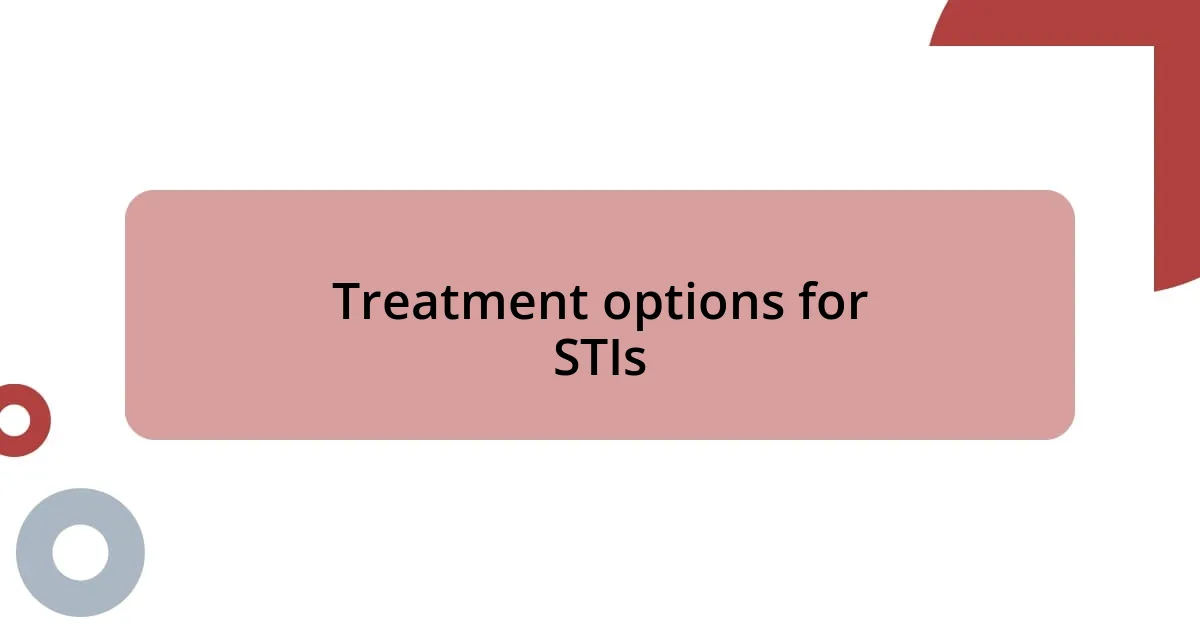Key takeaways:
- Open dialogue about STIs is essential to reduce stigma and promote awareness, enabling individuals to prioritize their sexual health.
- Regular STI testing and prompt recognition of symptoms can lead to early detection and better treatment outcomes.
- Understanding modes of transmission helps in practicing safer methods of intimacy and encourages proactive communication between partners.
- Treatment options vary for bacterial and viral STIs, with follow-up care being crucial for ensuring complete recovery and monitoring health.

Understanding common STIs
When we talk about common STIs, it’s shocking to realize just how prevalent they are. I remember a friend of mine once shared that she felt embarrassed discussing STIs, even with her doctor. This just shows how crucial it is to create an open dialogue where we can learn about these infections without fear or shame. Isn’t it unsettling how stigma can prevent us from staying informed?
One of the most frequently encountered STIs is chlamydia. I learned about it firsthand when a former partner disclosed their diagnosis. At first, I was taken aback, but I quickly understood the importance of getting tested. The reality is that many people may not show symptoms but can still spread the infection. This might make you wonder: how many infections go unnoticed?
Another common infection is gonorrhea, which can infect both men and women. The thought that it could go undetected made me quite anxious when I was first learning about it. I recall reading that it can lead to serious health issues if left untreated. This emphasizes why regular check-ups are so vital—our health often depends on proactive measures rather than reactions. What are your thoughts on the importance of check-ups in today’s world?

Symptoms of STIs to know
It’s essential to recognize the symptoms of STIs because early detection can significantly impact treatment outcomes. I recall a time when a close friend dismissed her unusual discharge as a minor issue, only to discover later it was a sign of an STI. This experience reinforced for me how vital it is to listen to our bodies.
Here are some common symptoms to be aware of:
– Unusual discharge from the genitals
– Pain during urination or intercourse
– Persistent itching or irritation in the genital area
– Sore throat or swollen lymph nodes (in the case of oral STIs)
– Rashes or sores in the genital region
Even mild symptoms shouldn’t be ignored; they may signify something more serious. In my experience, having open conversations about these signs can feel daunting, but it’s a crucial step toward staying healthy. Often, when I’ve discussed this with friends, they’ve been surprised to learn how many STIs can be asymptomatic until they escalate, highlighting the importance of regular testing and awareness.

How STIs are transmitted
When it comes to understanding how STIs are transmitted, it’s vital to recognize that these infections typically spread through direct contact. I remember a friend who was shocked to learn that even intimate behaviors like kissing or sharing towels could potentially transmit certain STIs. It made me realize how essential it is to have clear discussions about what these risks entail—we often think of penetration alone, but the spectrum is broader than we typically acknowledge.
Another critical route of transmission is through sexual contact, which includes vaginal, anal, and oral sex. I once thought that using condoms would eliminate the risk entirely, but I learned that while they significantly reduce it, they don’t provide 100% protection against all STIs. The discomfort of that realization sparked a deeper understanding within me about the need for regular testing and being informed about different protective methods beyond just barrier methods.
It’s also crucial to consider the role of bodily fluids, as many STIs can be spread through blood, semen, or vaginal fluids. I was taken aback when I discovered that some infections could even be transmitted without visible symptoms. This underscores the importance of openly communicating with partners about health and testing status—something that can feel awkward, but is essential. Have you ever navigated that conversation? Sharing my experiences with partners has always led to positive outcomes, fostering a sense of trust and transparency.
| Mode of Transmission | Examples of STIs |
|---|---|
| Sexual Contact | Chlamydia, Gonorrhea, HIV |
| Bodily Fluids | Hepatitis B, Syphilis |
| Direct Skin Contact | Herpes, HPV |

Importance of STI testing
Understanding the importance of STI testing can’t be overstated. I vividly remember the first time I went for testing; I felt a mix of anxiety and bravery. It was daunting, yet it turned out to be empowering. Testing not only helps to catch infections early but also alleviates the fear of the unknown. Isn’t it better to know and address an issue head-on rather than live with uncertainty?
Regular STI testing is a proactive step towards safeguarding your health and the health of your partners. I often reflect on how I used to underestimate the risk involved in casual encounters, thinking, “It won’t happen to me.” But after learning about common conditions like chlamydia and gonorrhea, which can lead to serious complications if untreated, I understood that ignorance wasn’t bliss—it was dangerous. Have you ever felt the weight of a potential health risk hanging over you? That realization alone pushed me to prioritize testing in a way I hadn’t considered before.
Moreover, STI testing fosters open communication within relationships, enhancing trust with your partners. I had a moment where I candidly discussed testing with someone I was dating. It led to a deeper conversation about our health, culminating in both of us getting tested together. The relief we felt afterward was palpable. It reminded me how vital this dialogue is, especially since we know that many STIs can be asymptomatic. Why risk transmitting something unknowingly when a simple test can provide peace of mind?

Preventing the spread of STIs
Preventing the spread of STIs starts with proactive communication. I’ve had experiences where talking openly with my partners about our sexual health led to a more intimate understanding of each other. It may feel uncomfortable initially, but isn’t it worth it to create an environment where both parties feel safe and informed?
Condoms are often the first line of defense, but I quickly learned that they aren’t foolproof against all STIs. There was a time when I relied solely on them without considering other barriers, like dental dams for oral sex, which can also reduce risk. I found that discussing these additional methods made a real difference in how both I and my partners perceived our safety during intimate moments.
Regular health check-ups are crucial, too. I recall a friend who initially thought getting tested was only necessary after risky encounters. But after experiencing the relief of a clean bill of health following consistent testing, they realized it’s more about routine care than just reaction. How often do we think about our sexual health in the same way we think about our general well-being? Embracing regular testing can become a comforting habit, reinforcing that our health deserves the same attention as any other part of our lives.

Treatment options for STIs
When it comes to treating STIs, the approach varies significantly depending on the type of infection. For bacterial STIs, such as chlamydia and gonorrhea, antibiotics are often the go-to solution. I remember feeling a wave of relief when I found out that treatment was often as simple as a quick course of pills. It was a stark contrast to the fear of what could happen if left untreated—knowing there’s a straightforward fix made all the difference.
On the other hand, viral STIs like HIV and herpes require a different strategy. While there’s currently no cure for these infections, antiviral medications can help manage symptoms and reduce transmission risks. I once had a friend who shared their journey with living with herpes, and their experience illuminated how consistent treatment can help someone lead a full, healthy life. Have you considered how advancements in medicine can change the narrative around these infections?
Additionally, follow-up care plays a critical role after treatment. I remember being advised to get retested a few weeks after my treatment, just to ensure everything was clear. This kind of proactive follow-up is essential; it’s like taking the extra step to ensure you’ve finished a race strong. Isn’t it comforting to know that taking responsibility for your health includes not just treatment, but also those essential check-ins afterward? It’s all part of a comprehensive approach to maintaining your well-being.

Reducing stigma around STIs
Reducing the stigma around STIs is vital for creating a healthier society. I remember my own hesitations when discussing STIs; the fear of judgment loomed large. Can you imagine how many people might avoid seeking help because they worry about what others will think? Normalizing these conversations can empower individuals to prioritize their sexual health without fear.
When I started sharing my experiences with STIs openly, it was eye-opening to see how others reacted. Friends who had felt isolated suddenly opened up about their own journeys, and it turned into a supportive discussion. The shared laughter, relief, and understanding that we weren’t alone made me realize the importance of transparency. What if we all embraced this vulnerability? It could transform our relationships and the culture surrounding sexual health.
Even on social media, I try to post positively about sexual health matters. I once shared a simple infographic that explained common STIs and their effects. The feedback was incredible! People expressed gratitude for the information, and it sparked meaningful conversations in my community. How powerful is that? Education and honest dialogue can combat misinformation and help dismantle the unnecessary stigma that too often surrounds these issues.














